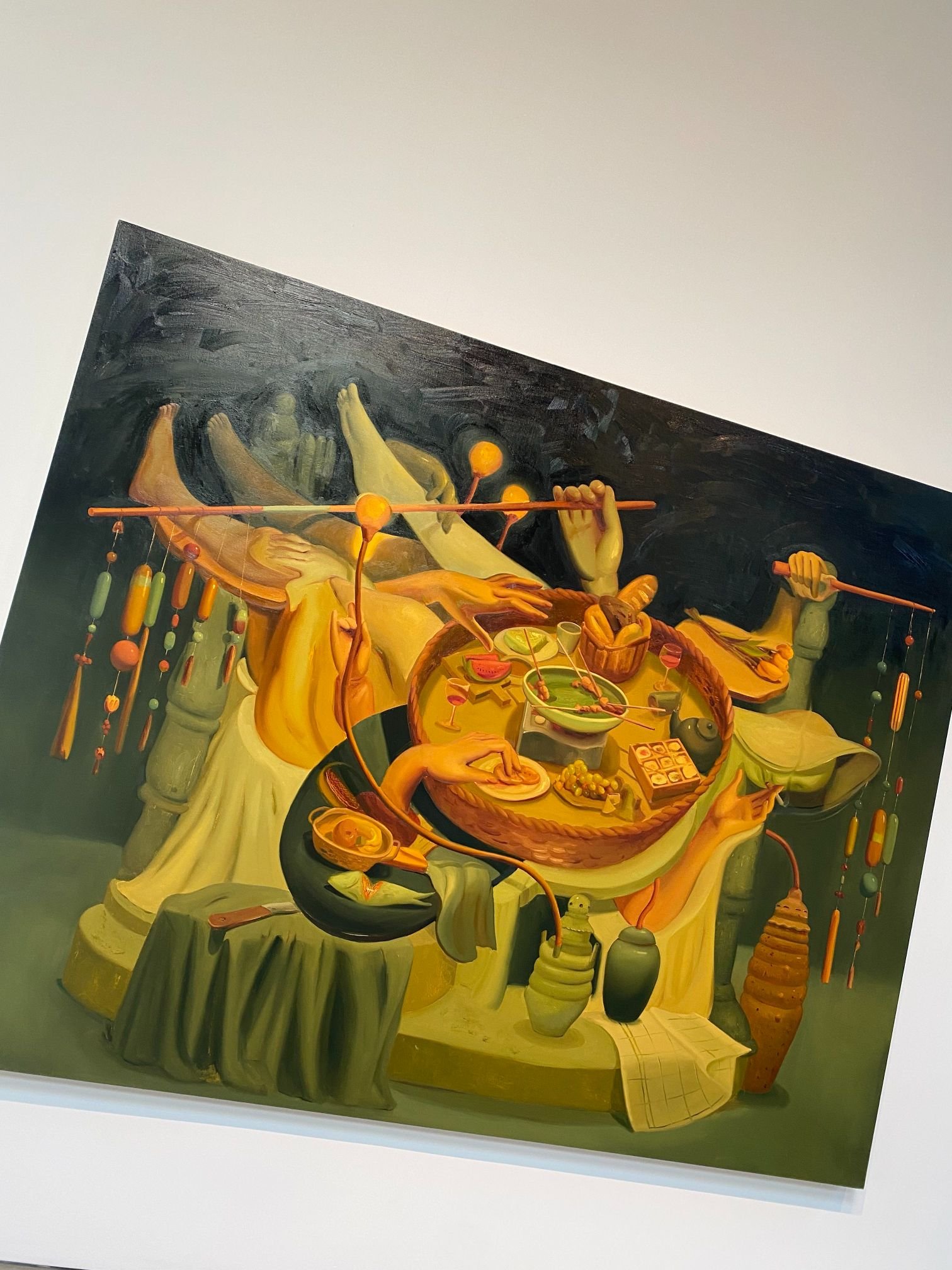Who said, “Painting is dead?” You’d be surprised to learn that this line was uttered by French painter Paul Delaroche in 1840 after seeing the first photographic image. Twenty-three years later, Édouard Manet painted his masterwork, Le Déjeuner sur l’herbe (1863), or Luncheon on the Grass, and modernism was born. Painting wasn’t dead, it was finally in dialogue with the zeitgeist. With Luncheon, Manet was deliberately trying to ruffle the feathers of the traditionally neoclassical establishment. Painted on a large canvas, a scale usually reserved for gods, mythic figures, and biblical representations, Luncheon was rendered with harsh, sometimes visible brushstrokes and a nearly hallucinatory depth of field. The background bather looks primordially copy and pasted, and the starkly illuminated female nude in the foreground, next to two formally dressed men, ambiguously gazes at the viewer with an uncertain contract of consent. Like Bob Dylan’s songbook, Luncheon has been covered and remixed ad infinitum, almost from the onset of the painting’s public unveiling. And now, three centuries after Manet shocked French society, more than thirty of today’s leading painters reinterpret this modernist asteroid in oil pigments at “Luncheon on the Grass— Contemporary Responses to Édouard Manet's Le Déjeuner sur l’herbe” at Jeffrey Deitch Gallery. The group exhibition is an electric vision of a new zeitgeist, a new cosmological panoply of race, gender, class and sexuality. Many of the paintings, like Ariana Papademetropoulos’ It Becomes Blurry In The Moment (2022), are so new they are virtually wet and hang with a particular urgent immediacy, like a song coming out of the speaker for the first time. Caitlin Cherry’s Mixed Clout Relationships—Feast of the Ass (2022), is a pornographic dreamscape of famous, full-frontal rappers and clout chasers depicted in a dark fragmentation of orgiastic bodies, like a fractured plasma screen television. Other recent paintings include 57-year-old Chinese painter Liu Xiaodong's Newcomers in the Village - Response to Manet (2021), which was painted on location in Changchun in Northern China and depicts a group of friends and collaborators. Newcomers, and also a work by rising artist, Dominique Fung, called Sans Les Mains (2022), offers a fresh and rare depiction of AAPI visibility along the white hegemonic power structures of modernism. There is also Vaughn Spann’s incredible Juneteenth on the grass—after lunch (2022), which features the artist’s double-headed figures with the bather almost lost in the large expanse of a bay as fireworks explode overhead. The oldest work in the show is by the late, French New Realist, Alain Jacquet—a silkscreen on canvas entitled Le dejeuner sur l’herbe (1964)—and depicts our nude muse in the foreground, our two fully-dressed men, and our bather in the background, but in the context of a typically midcentury constellation of saturated Ben Day dots and a crystalline blue pool that harkens Cannes or some other Provençal locale on a sizzling summer day. Then there is Somaya Critchlow’s dynamic and evocative Mr. Peanut!—The Picnic (2020-2021), a delicately small painting that is a grenade packed with the ammonium nitrate and TNT of racial undertones. Mr. Peanut, whose full name is the rather colonial sounding Bartholomew Richard Fitzgerald-Smythe and was created in the image of the slave owning plantation masters of the Virginian and North Carolina peanut farms, is pictured with his white gloves, monocle, and top hat cupping the breast and kissing a Black woman. But perhaps the most direct response to Manet’s modernist masterpiece comes from Iranian-born painter Tala Madani with her 15x12 inch oil on linen, entitled Pickled (2022), which features a turd swimming in a jar that is half filled (or is it half empty?) with urine—our bather is mysterious, fecal and anonymous—there is no gender, no race—thousands of years of art history boiled down to a single piece of shit in a mason jar. Luncheon on the Grass will be on view until May 7, 2022 at Jeffrey Deitch Gallery. text by Oliver Kupper
"The Emerald Tablet" A Curatorial Project by Ariana Papademetropoulos Opening At Jeffrey Deitch
The Emerald Tablet is modeled on Dorothy’s quest to The Emerald City in Frank Baum’s “The Wizard of Oz” and invokes its iconography to ignite the dialogue between esotericism and popular culture. As a fervent Theosophist, a religious movement that flourished in Los Angeles at the turn of the century, Baum’s Emerald City is a reference to “The Emerald Tablet of Hermes,” an ancient text that formed the foundations of alchemy and all subsequent western occult traditions. On view until October 23 at Jeffrey Deitch. photographs by Oliver Kupper
Nick Zinner and Ariana Papademetropoulos At The Opening of Her Exhibition Wonderland Avenue @ MAMA Gallery
photograph by Oliver Maxwell Kupper




































